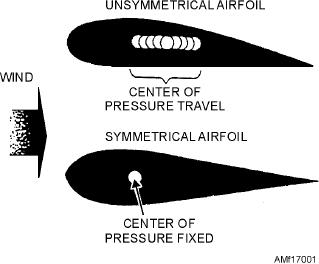
CHAPTER 17
ROTARY-WING FLIGHT CONTROL SYSTEMS
INTRODUCTION
this type of airfoil were on a rotary-wing aircraft, it
would cause the rotor blades to jump around
The helicopter has become a vital part of naval
uncontrollably. With the symmetrical airfoil, this
aviation. The helicopter, known also as a rotary-wing
undesirable effect does not exist. The airfoil, when
aircraft, has many military applications. It has
rotated, travels smoothly through the air.
antisubmarine warfare (ASW) and search and rescue
Rotor lift can be explained by either of two
functions, as well as minesweeping and amphibious
theories. The first theory uses Newton's law of
warfare functions. The advantages of the helicopter
momentum. Lift results from accelerating a mass of air
over conventional aircraft are that lift and control are
downward. This action is similar to jet thrust, which
relatively independent of forward speed. A helicopter
develops by accelerating a mass of air out the exhaust.
can fly forward, backward, sideways, or remain in
The second theory is the blade element theory. The
stationary flight above the ground (hover). Helicopters
airflow over an airfoil section (blade element) of the
do not require runways for takeoffs or landings. The
rotor blade acts the same as it does on a fixed-wing
decks of small ships or open fields provide an adequate
aircraft. The simple momentum theory determines
landing area.
only the lift characteristic; while the blade element
theory gives both lift and drag characteristics. This
ROTARY-WING THEORY OF FLIGHT
theory gives us a more complete picture of all the
forces acting on a rotor blade.
LEARNING OBJECTIVE: Recognize the
Lift changes by increasing the angle of attack or
principles of aerodynamics peculiar to the
pitch of the rotor blades. This action produces enough
flight of rotary-wing aircraft.
lift to raise the helicopter off the ground and keep it in
the air. On a helicopter, when the rotor is turning and
The same basic aerodynamic principles apply to
the blades are at zero angle of attack, no lift is
rotary-wing aircraft as fixed-wing aircraft. The main
developed. This feature provides the pilot with
difference between the two types of aircraft is in the
complete control of the lift developed by the rotor
way lift occurs. The fixed-wing aircraft gets its lift
blades.
from a fixed airfoil surface. The helicopter gets lift
ROTOR AREA
from rotating airfoils called rotor blades. The word
helicopter comes from Greek words meaning helical
One assumption made is that the lift depends upon
wing or rotating wing. A helicopter uses one or more
the entire area of the rotor disc. The rotor disc area is
engine-driven rotors, from which it gets lift and
propulsion.
The main rotor of a helicopter consists of two or
more rotor blades. The airfoils of a helicopter are
perfectly symmetrical. This means that the upper and
lower surfaces are alike. This fact is one of the major
differences between a fixed-wing aircraft's airfoil and
the helicopter's airfoil. The airfoil on a fixed-wing
aircraft has a greater camber on the upper surface than
on the lower surface. The helicopter's airfoil camber is
the same on both surfaces. See figure 17-1.
Helicopters have symmetrical airfoils because the
center of pressure across its surface should not move.
On the fixed-wing airfoil, the center of pressure moves
fore and aft, along the chord line. The center of
pressure changes with changes in the angle of attack. If
Figure 17-1.--Center of pressure.
17-1

